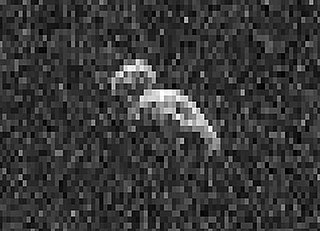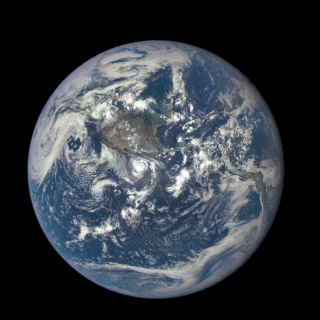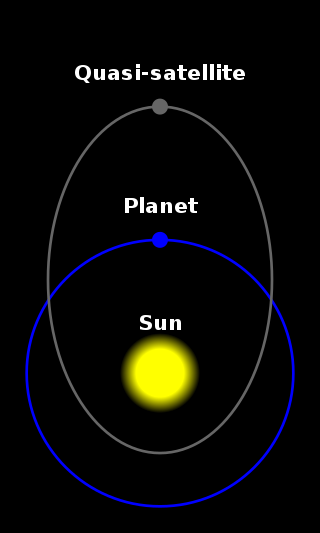
A near-Earth object (NEO) is any small Solar System body orbiting the Sun whose closest approach to the Sun (perihelion) is less than 1.3 times the Earth–Sun distance. This definition applies to the object's orbit around the Sun, rather than its current position, thus an object with such an orbit is considered an NEO even at times when it is far from making a close approach of Earth. If an NEO's orbit crosses the Earth's orbit, and the object is larger than 140 meters (460 ft) across, it is considered a potentially hazardous object (PHO). Most known PHOs and NEOs are asteroids, but about 0.35% are comets.

3753 Cruithne is a Q-type, Aten asteroid in orbit around the Sun in 1:1 orbital resonance with Earth, making it a co-orbital object. It is an asteroid that, relative to Earth, orbits the Sun in a bean-shaped orbit that effectively describes a horseshoe, and that can change into a quasi-satellite orbit. Cruithne does not orbit Earth and at times it is on the other side of the Sun, placing Cruithne well outside of Earth's Hill sphere. Its orbit takes it near the orbit of Mercury and outside the orbit of Mars. Cruithne orbits the Sun in about one Earth year, but it takes 770 years for the series to complete a horseshoe-shaped movement around Earth.

A natural satellite is, in the most common usage, an astronomical body that orbits a planet, dwarf planet, or small Solar System body. Natural satellites are colloquially referred to as moons, a derivation from the Moon of Earth.

2002 AA29 (also written 2002 AA29) is a small near-Earth asteroid that was discovered on January 9, 2002 by the LINEAR (Lincoln Near Earth Asteroid Research) automatic sky survey. The diameter of the asteroid is only about 20–100 metres (70–300 ft). It revolves about the Sun on an almost circular orbit very similar to that of the Earth. This lies for the most part inside the Earth's orbit, which it crosses near the asteroid's furthest point from the Sun, the aphelion. Because of this orbit, the asteroid is classified as Aten type, named after the asteroid 2062 Aten.
2003 YN107 is a tiny asteroid, classified as a near-Earth object of the Aten group moving in a 1:1 mean-motion resonance with Earth. Because of that, it is in a co-orbital configuration relative to Earth.

A quasi-satellite is an object in a specific type of co-orbital configuration with a planet where the object stays close to that planet over many orbital periods.

Claims of the existence of other moons of Earth—that is, of one or more natural satellites with relatively stable orbits of Earth, other than the Moon—have existed for some time. Several candidates have been proposed, but none have been confirmed. Since the 19th century, scientists have made genuine searches for more moons, but the possibility has also been the subject of a number of dubious non-scientific speculations as well as a number of likely hoaxes.
2006 RH120 is a tiny near-Earth asteroid and fast rotator with a diameter of approximately 2–3 meters that ordinarily orbits the Sun but makes close approaches to the Earth–Moon system around every twenty years, when it can temporarily enter Earth orbit through temporary satellite capture (TSC). Most recently, it was in Earth orbit from July 2006 to July 2007, during which time it was never more than 0.0116 AU (1.74 million km) from Earth. As a consequence of its temporary orbit around the Earth, it is currently the second smallest asteroid in the Solar System with a well-known orbit, after 2021 GM1. Until given a minor planet designation on 18 February 2008, the object was known as 6R10DB9, an internal identification number assigned by the Catalina Sky Survey.

An Earth trojan is an asteroid that orbits the Sun in the vicinity of the Earth–Sun Lagrange points L4 (leading 60°) or L5 (trailing 60°), thus having an orbit similar to Earth's. Only two Earth trojans have so far been discovered. The name "trojan" was first used in 1906 for the Jupiter trojans, the asteroids that were observed near the Lagrangian points of Jupiter's orbit.

A minor planet is "lost" when today's observers cannot find it, because its location is too uncertain to target observations. This happens if the orbital elements of a minor planet are not known accurately enough, typically because the observation arc for the object is too short, or too few observations were made before the object became unobservable.
2014 OL339 (also written 2014 OL339) is an Aten asteroid that is a temporary quasi-satellite of Earth, the fourth known Earth quasi-satellite.
2009 BD is a very small asteroid, approximately 10 meters in diameter, which is classified as near-Earth object of the Apollo group and as an Earth co-orbital asteroid.

WT1190F was a small temporary satellite of Earth that impacted Earth on 13 November 2015 at 06:18:21.7 UTC. It is thought to have been space debris from the trans-lunar injection stage of the 1998 Lunar Prospector mission. It was first discovered on 18 February 2013 by the Catalina Sky Survey. It was then lost, and reacquired on 29 November 2013. It was again discovered on 3 October 2015 by astronomer Rose Garcia with the Catalina Sky Survey 60-inch telescope, and the object was soon identified to be the same as the two objects previously sighted by the team, who have been sharing their data through the International Astronomical Union's Minor Planet Center (MPC). An early orbit calculation showed that it was orbiting Earth in an extremely elliptical orbit, taking it from within the geosynchronous satellite ring to nearly twice the distance of the Moon. It was also probably the same object as 9U01FF6, another object on a similar orbit discovered on 26 October 2009.
2015 SO2 (astronomical naming convention: 2015 SO2) is an Aten asteroid that is a temporary horseshoe companion to the Earth, the ninth known Earth horseshoe librator. Prior to its most recent close encounter with our planet (2015 September 30) it was an Apollo asteroid.
A temporary satellite is an object which has been captured by the gravitational field of a planet and thus has become the planet's natural satellite, but, unlike irregular moons of the larger outer planets of the Solar System, will eventually either leave its orbit around the planet or collide with the planet. The only observed examples are 2006 RH120, a temporary satellite of Earth for twelve months from July 2006 to July 2007, 2020 CD3 and 2022 NX1. Some defunct space probes or rockets have also been observed on temporary satellite orbits.

2020 BX12 is a sub-kilometer binary asteroid, classified as a near-Earth asteroid and potentially hazardous object of the Apollo group. It was discovered on 27 January 2020 by the Asteroid Terrestrial-impact Last Alert System survey at the Mauna Loa Observatory during its approach to Earth of 0.02915 AU (4.361 million km; 11.34 LD). Radar observations of the asteroid were carried out by the Arecibo Observatory on 4 February 2020, revealing a natural satellite orbiting 360 m (1,180 ft) from the primary body.

2020 CD3 (also CD3 for short) is a tiny near-Earth asteroid (or minimoon) that ordinarily orbits the Sun but makes close approaches to the Earth–Moon system, in which it can temporarily enter Earth orbit through temporary satellite capture (TSC). It was discovered at the Mount Lemmon Observatory by astronomers Theodore Pruyne and Kacper Wierzchoś on 15 February 2020, as part of the Mount Lemmon Survey or Catalina Sky Survey. The asteroid's discovery was announced by the Minor Planet Center on 25 February 2020, after subsequent observations confirmed that it was orbiting Earth.

2020 SO is a near-Earth object identified to be the Centaur upper stage used on 20 September 1966 to launch the Surveyor 2 spacecraft. The object was discovered by the Pan-STARRS 1 survey at the Haleakala Observatory on 17 September 2020. It was initially suspected to be an artificial object due to its low velocity relative to Earth and later on the noticeable effects of solar radiation pressure on its orbit. Spectroscopic observations by NASA's Infrared Telescope Facility in December 2020 found that the object's spectrum is similar to that of stainless steel, confirming the object's artificial nature. Following the object's confirmation as space debris, the object was removed from the Minor Planet Center's database on 19 February 2021.
2020 SL1 is a near-Earth asteroid of the Apollo group, discovered by the Pan-STARRS 1 survey at Haleakala Observatory, Hawaii on 18 September 2020. With an estimated diameter of 0.9–2.0 km (0.56–1.24 mi), it is the largest potentially hazardous asteroid discovered in 2020.
(614689) 2020 XL5 (provisional designation 2020 XL5) is a near-Earth asteroid and Earth trojan discovered by the Pan-STARRS 1 survey at Haleakala Observatory, Hawaii on 12 December 2020. It oscillates around the Sun–Earth L4 Lagrangian point (leading 60°), one of the dynamically stable locations where the combined gravitational force acts through the Sun's and Earth's barycenter. Analysis of 2020 XL5's trojan orbit stability suggests it will remain around Earth's L4 point for at least four thousand years until gravitational perturbations from repeated close encounters with Venus destabilize its trojan configuration. With a diameter about 1.2 km (0.75 mi), 2020 XL5 is the second Earth trojan discovered, after 2010 TK7, and is the largest of its kind known.













